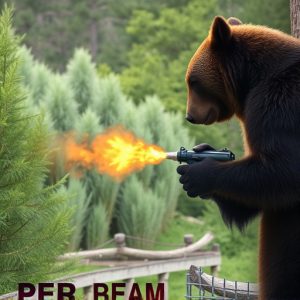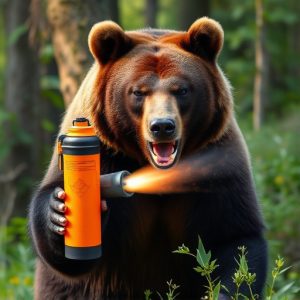Mastering Bear Spray Quick Draw: Wind Direction Safety Tips
Proper usage of bear spray depends heavily on understanding wind direction safety tips. Aiming for a…….
Proper usage of bear spray depends heavily on understanding wind direction safety tips. Aiming for a bear's face and eyes, into a headwind or at a 90-degree angle to the wind, ensures the spray reaches the animal's breathing zone effectively. Spraying into a tailwind may not deter a bear and could pose self-defense risks by blowing the spray back onto the user. Positioning yourself with the wind at your back enhances coverage, often overlooked but crucial for safety during bear encounters. Regular training in drawing techniques, keeping the spray charged, and inspecting the nozzle ensures swift and effective deployment when needed.
“In regions frequented by bears, knowing how to respond during encounters is crucial. This article delves into the essential components of bear spray holster quick draw access, focusing on wind direction safety tips. Understanding the effectiveness of bear spray and mastering secure, quick draw techniques can significantly enhance your survival chances in a potential encounter. By optimizing wind direction and ensuring easy accessibility, you maximize the spray’s impact, providing a vital layer of protection.”
- Understanding Bear Spray and Its Effectiveness
- The Importance of Wind Direction in Bear Encounters
- Secure and Quick Draw Techniques for Bear Spray Holsters
- Safety Tips to Maximize Bear Spray Wind Direction and Accessibility
Understanding Bear Spray and Its Effectiveness
Bear spray is a crucial tool for outdoor enthusiasts navigating bear country. Its effectiveness relies heavily on proper usage, which includes understanding wind direction safety tips. When deployed correctly, bear spray can create a barrier between you and an attacking bear by temporarily blinding and disorienting it. However, the spray’s reach and impact are significantly influenced by environmental factors, particularly wind direction.
For optimal results, users should aim for the bear’s face and eyes, ensuring the spray flows into the animal’s breathing zone. In terms of wind direction safety tips, it’s best to use bear spray into a headwind or at a 90-degree angle to the bearing wind. This prevents the spray from blowing back towards you and increases the likelihood of effective deterrence. Conversely, spraying into a tailwind could result in self-defense issues, as the spray might not reach the bear and could potentially blow back onto the user.
The Importance of Wind Direction in Bear Encounters
In a bear encounter, understanding wind direction is crucial for your safety. When carrying and deploying bear spray, the wind plays a significant role in its effectiveness. If the wind is blowing towards you or away from the bear, it can significantly reduce the reach and impact of the spray. Ideally, you want the wind to be at your back, pushing the spray towards the bear, ensuring maximum coverage and distance. This simple factor can make all the difference in a potentially dangerous situation.
Bear spray is designed to create a barrier between you and the bear, temporarily incapacitating it to give you time to retreat or defend yourself. Knowing which way the wind is blowing allows you to strategically position yourself, ready to deploy the spray effectively. Safety tips often emphasize the importance of staying calm, assessing the situation, and using the wind to your advantage when facing a bear, especially in areas known for bear activity.
Secure and Quick Draw Techniques for Bear Spray Holsters
When it comes to securing and drawing bear spray, understanding the wind direction is crucial for safety tips. Always ensure your holster is firmly attached and oriented in a way that allows for quick access, even under stressful situations. The draw mechanism should be smooth and reliable, enabling you to deploy the spray directly towards the bear’s face or eyes—the key areas for maximum effectiveness.
For optimal performance, practice drawing techniques in various positions and weather conditions. Consider factors like visibility and distance when aiming, as these influence both accuracy and safety. Remember, proper training and regular exercises will help you become more proficient in using your bear spray holster, ensuring a faster response time during an encounter.
Safety Tips to Maximize Bear Spray Wind Direction and Accessibility
When carrying bear spray, understanding how wind direction impacts its effectiveness is key to maximizing safety in potential encounters. Aim for a crosswind approach when deploying your bear spray. This means holding the nozzle at an angle away from your body and towards the approaching bear. A crosswind ensures that you’re not spraying directly into the face of the bear or yourself, which can be dangerous if the spray blows back.
Regularly practice quick-draw access to your bear spray holster. Ensure it’s within easy reach, allowing for a swift response. Keep your spray charged and regularly inspect the nozzle for any blockages. Remember, in a bear encounter, every second counts, so prioritize keeping your equipment in top condition and be prepared to deploy it instantly.
In conclusion, mastering the art of quick draw with a bear spray holster is a valuable skill for anyone venturing into bear country. By understanding the effectiveness of bear spray, recognizing wind direction during encounters, and implementing secure holding techniques, individuals can significantly enhance their safety when faced with potential bear threats. Following these essential bear spray wind direction safety tips will ensure optimal accessibility and maximum protection during outdoor adventures in bear habitats.


